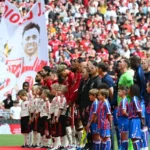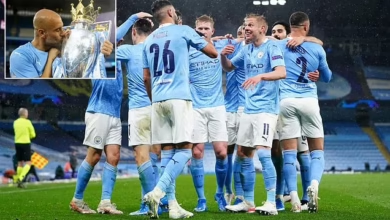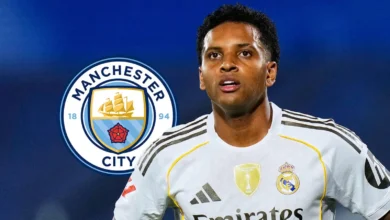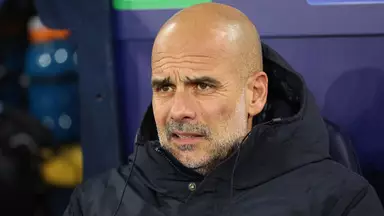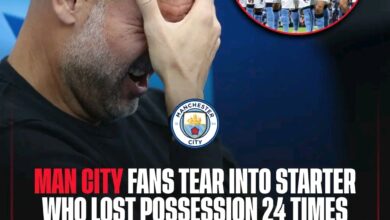Liverpool 2.0: The Dawn of a New Era at Wembley
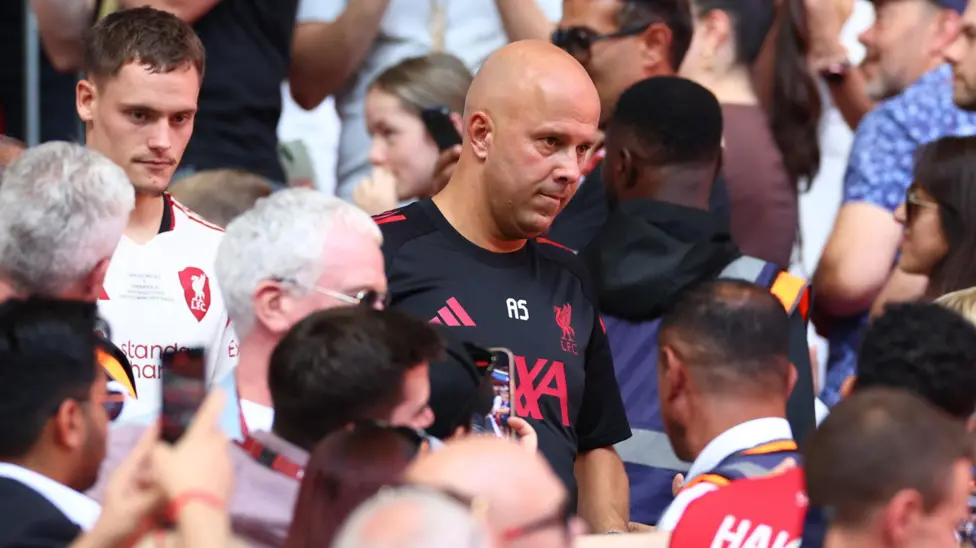
The grand theater of Wembley Stadium witnessed the unveiling of Arne Slot’s Liverpool 2.0 on a sun-drenched Sunday afternoon, marking the beginning of what promises to be a transformative chapter in the club’s storied history. The Community Shield, often dismissed as a mere pre-season friendly with silverware attached, took on heightened significance as four new signings made their competitive debuts in the famous red jersey. What unfolded was a compelling narrative of promise and peril, brilliance and bewilderment, as Liverpool’s £116 million summer investment received its first serious examination under the unforgiving lights of competitive football.
The Dutch tactician, who succeeded the beloved Jurgen Klopp in one of football’s most challenging succession stories, watched his reimagined Liverpool side deliver a performance that encapsulated both the potential and the growing pains inherent in any major overhaul. The 2-2 draw that preceded a penalty shootout defeat to Crystal Palace was far more than a simple result; it was a comprehensive case study in the complexities of modern football transformation.
At the heart of Liverpool’s summer reconstruction stood Florian Wirtz, the German playmaker whose record-breaking £116 million transfer from Bayer Leverkusen represented the club’s most ambitious statement of intent in recent memory. Flanked by the attacking full-back pairing of Jeremie Frimpong and Milos Kerkez, and spearheaded by the promising Hugo Ekitike, this quartet represented a fundamental shift in Liverpool’s tactical DNA.
The selection of these four new faces in the starting eleven was itself a bold declaration from Slot, demonstrating an unwavering belief in his summer acquisitions and a willingness to accelerate the integration process. Only Georgian goalkeeper Giorgi Mamardashvili remained on the bench, with Alisson Becker retaining his position between the posts as the sole constant in an otherwise revolutionary lineup.
The statistical significance of the afternoon was not lost on observers. Ekitike and Frimpong’s goals marked the first time since August 2006 that two Liverpool players had scored on their competitive debuts, when Craig Bellamy and Mark Gonzalez found the net against Maccabi Haifa. This historical parallel served as a reminder of Liverpool’s capacity for renewal and reinvention, even as it highlighted the magnitude of the current transformation.
Perhaps nowhere was the evolution of Slot’s Liverpool more evident than in the deployment of the full-backs, positions that had been synonymous with the attacking dynamism of Trent Alexander-Arnold and Andy Robertson under Klopp’s regime. Frimpong and Kerkez, while undeniably attacking in their natural inclinations, brought a distinctly different flavor to these crucial positions.
The tactical heat maps revealed fascinating insights into this transformation. While Kerkez’s positioning bore striking similarities to Robertson’s traditional approach, hugging the left touchline and providing consistent width, Frimpong’s deployment marked a more radical departure. Rather than drifting into central midfield as Alexander-Arnold had become famous for, the Dutch international maintained a disciplined wide position, almost functioning as a traditional winger at times.
This positional discipline paid immediate dividends when Frimpong opened his Liverpool account with a moment of sublime skill. His 21st-minute goal, a delicate chip over Dean Henderson after a mazy run into the penalty area, demonstrated the kind of direct threat that wide positioning can provide. Whether the execution was intentional or fortuitous mattered little; the result was a spectacular introduction to Liverpool’s attacking philosophy under Slot.
The contrast in approach became even more pronounced when examining the average positions data. Frimpong’s adherence to the right touchline created a width that had been less consistent in Alexander-Arnold’s more fluid role, potentially offering greater tactical predictability for teammates while maintaining the attacking threat that Liverpool’s system demands.
However, this transformation was not without its defensive complications. The very attacking instincts that made Frimpong such a potent weapon in Liverpool’s forward play also contributed to defensive vulnerabilities. His positioning for Crystal Palace’s second equalizer, where Ismaila Sarr was played onside, served as a stark reminder that the integration of new tactical approaches requires time and refinement.
If the full-back positions represented evolution, then Florian Wirtz’s role embodied revolution. The German international was deployed in a position of unprecedented freedom within Liverpool’s tactical framework, operating as an advanced playmaker with license to roam across the final third. This represented a significant departure from Liverpool’s previous season, where no player had been given such an advanced creative brief.
Wirtz’s influence was immediately apparent and statistically overwhelming. By the time of his 84th-minute substitution, he had completed more passes than any Liverpool player, made more entries into the final third, delivered more crosses, and registered more touches in Palace’s penalty area than any teammate. His heat map revealed a player comfortable operating across the width of the attacking third, though with a natural gravitational pull toward the left side of the pitch.
The German’s performance was a masterclass in modern playmaking, combining technical excellence with tactical intelligence. His role in Liverpool’s opening goal perfectly encapsulated his value to the team. After 66 seconds of patient build-up play involving 22 passes and nine players, it was Wirtz who provided the killer pass to release Ekitike for the opener. The goal was a testament to both individual brilliance and collective understanding, suggesting that the integration of Liverpool’s new tactical approach was proceeding faster than might have been expected.
Former Crystal Palace striker Glenn Murray’s assessment captured the broader sentiment surrounding Wirtz’s debut: “It has been a really impressive performance for Wirtz. Very dominant. He was tiring by the end of it and that is something he will need to get used to. But he is looking like a very good signing.”
This dominance raised intriguing questions about how Liverpool’s existing stars would adapt to the new tactical hierarchy. Mohamed Salah’s subdued performance, marked by limited goal threat and a penalty miss in the shootout, hinted at the adjustments required throughout the squad as players adapt to new roles and responsibilities.
Hugo Ekitike’s introduction as Liverpool’s new central striker brought both excitement and a sense of déjà vu. His opening goal, scored within minutes of kickoff, showcased the clinical finishing that Liverpool had hoped to acquire. The French striker’s movement in the penalty area and his ability to find space in crowded areas suggested that Liverpool might finally have found a solution to their long-standing striker conundrum.
The goal itself carried historical significance, representing the quickest Community Shield goal since Gary McAllister’s effort for Liverpool against Manchester United in 2001. Such statistics, while ultimately trivial, served to emphasize the immediate impact that Ekitike was capable of making.
Yet the afternoon also revealed familiar frustrations. Ekitike’s miss from close range early in the second half, where he directed a header over the crossbar from inside the six-yard box, evoked uncomfortable memories of Darwin Nunez’s profligacy. Another chance blazed over from 12 yards added to the sense that Liverpool’s striker position remained a work in progress despite the summer investment.
The parallel with Nunez’s own Community Shield debut was particularly striking. The Uruguayan had also scored on his debut in this fixture, looking impressive in a victory over Manchester City in 2023, only to struggle with consistency throughout the subsequent season. While drawing direct comparisons would be premature, the similarity served as a reminder that Community Shield performances, no matter how encouraging, provide limited predictive value for long-term success.
Ekitike’s technical ability was evident throughout the match, particularly in a sumptuous cross with the outside of his boot that found Cody Gakpo in an offside position. Such moments of quality suggested that the raw materials for success were present, requiring only time and tactical familiarity to reach full potential.
While Liverpool’s attacking play provided plenty of encouragement, defensive concerns emerged as a recurring theme throughout the afternoon. The ease with which Crystal Palace created their two major chances raised questions about the structural solidity of Slot’s system, particularly in transition moments.
The first-half penalty, conceded when Virgil van Dijk fouled Sarr after the Palace winger had been released by a simple through ball, highlighted potential vulnerabilities in Liverpool’s defensive positioning. The second goal, where Sarr burst through the Liverpool defense with twelve minutes remaining, demonstrated similar issues with defensive coordination and communication.
Slot’s post-match assessment was characteristically blunt: “We don’t concede chances, but we concede goals.” This observation captured the essence of Liverpool’s defensive concerns – while they were not being systematically overwhelmed, they were being punished ruthlessly for their mistakes.
The absence of recognized defensive depth became apparent when examining Liverpool’s bench composition. With no additional center-backs available, and Joe Gomez sidelined with a minor injury, Liverpool’s defensive options appeared concerningly thin. The departure of Jarell Quansah to Bayer Leverkusen had further depleted the squad’s defensive resources, creating an urgent need for additional reinforcement before the transfer window’s closure.
Intriguingly, the player Liverpool most coveted to address these defensive concerns was captaining the opposition at Wembley. Marc Guehi’s commanding performance for Crystal Palace, leading by example until cramp forced his late substitution, served as a reminder of the quality Liverpool were hoping to acquire. With Guehi entering the final year of his contract at Selhurst Park, the transfer speculation surrounding his potential move to Anfield gained additional relevance.
The midfield battle revealed both the potential and the current limitations of Liverpool’s squad depth. Ryan Gravenberch’s absence due to the birth of his child and Alexis Mac Allister’s limited fitness meant that Curtis Jones and Dominik Szoboszlai were tasked with providing stability in the deeper midfield positions.
Jones’s performance was notably composed, completing all 53 of his attempted passes without error. This statistical perfection demonstrated the young Englishman’s technical reliability and tactical discipline, qualities that would prove essential as Liverpool navigated their transitional period. However, the lack of available alternatives highlighted the need for additional midfield depth, particularly given the physical demands of Slot’s pressing system.
Former Liverpool goalkeeper Chris Kirkland’s assessment emphasized Gravenberch’s importance to the current setup: “Gravenberch was a massive miss today – he was my player of the season last year.” This observation underscored how crucial the Dutch midfielder’s energy and ball-carrying ability had become to Liverpool’s tactical framework.
The midfield dynamic also revealed how Wirtz’s advanced positioning had created space for more traditional central midfield play. With the German operating almost as a second striker at times, Jones and Szoboszlai were able to focus on their primary responsibilities without the need to provide extensive creative input. This tactical clarity represented a significant shift from previous seasons, where midfield players had often been required to fulfill multiple roles simultaneously.
As Liverpool’s attacking display flickered between brilliant and wasteful, the ongoing speculation surrounding Newcastle United’s Alexander Isak gained renewed significance. The Swedish striker’s potential availability had been a recurring theme throughout the summer transfer window, with reports suggesting mutual interest between player and club.
The Community Shield performance crystallized the argument both for and against pursuing Isak’s signature. On one hand, Ekitike’s promising debut and the successful integration of multiple new signings suggested that Liverpool’s striker requirements might already be adequately addressed. On the other hand, the missed chances and the familiar frustrations of profligate finishing served as reminders of why additional options might prove valuable.
Kirkland’s post-match comments reflected this duality: “Liverpool want another striker. We’re all greedy. Every team wants as many strikers as they can. Liverpool want Isak, they have bid for him, and he wants to go. Normally, when that is the case, a deal gets done.”
The financial implications of such a mo





